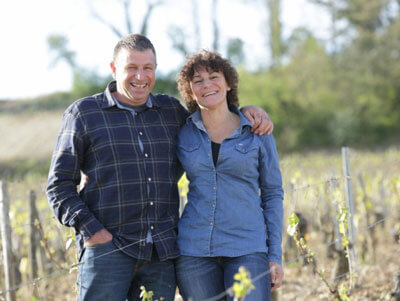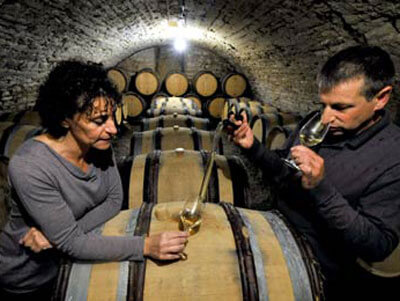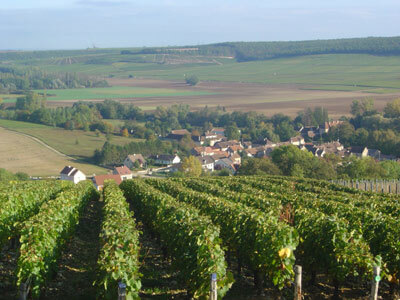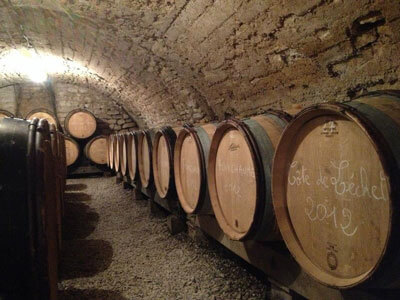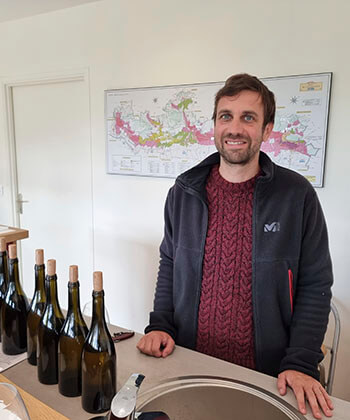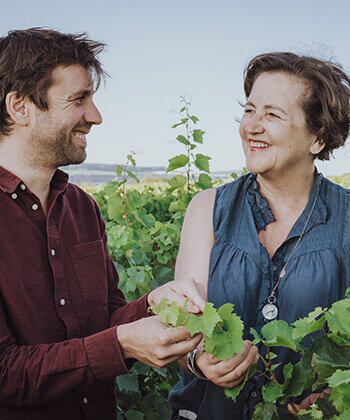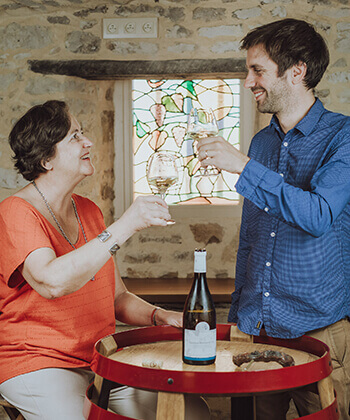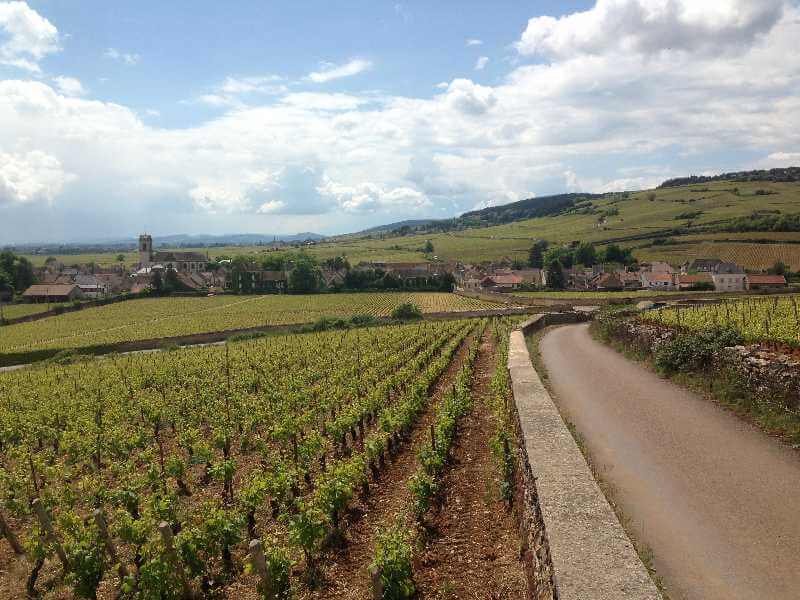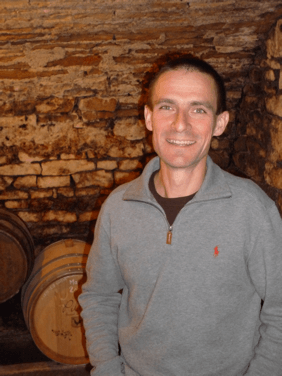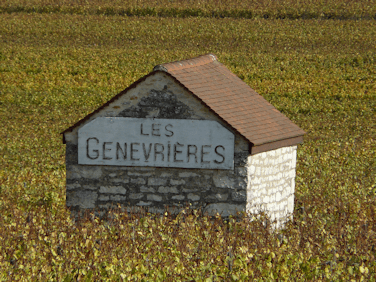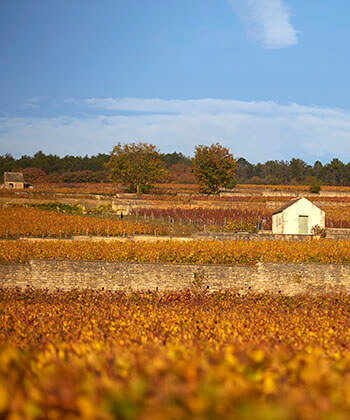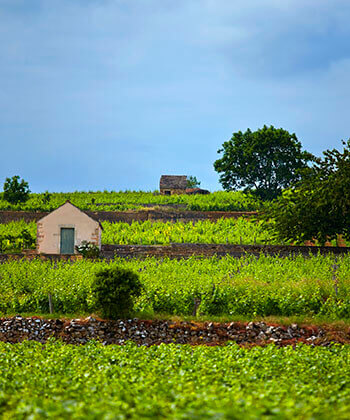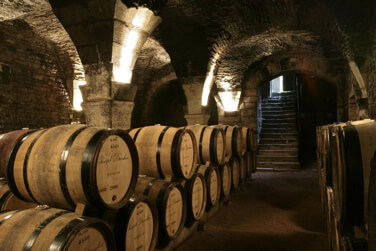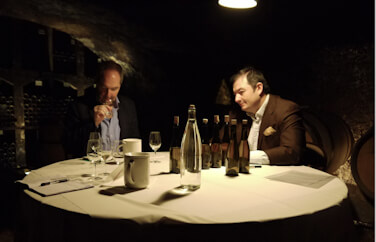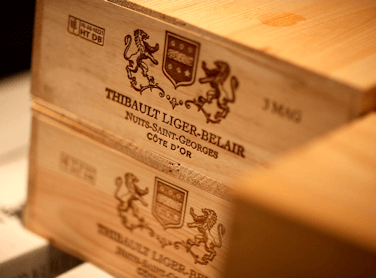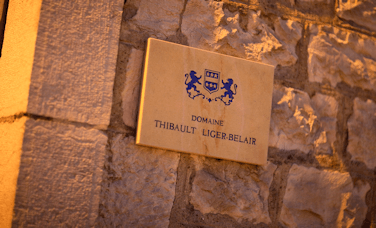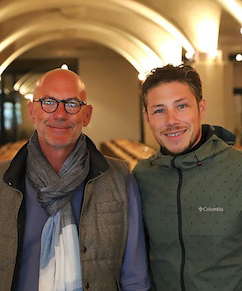White Bigger Bottles
Please note that some of the web pages may take a few moments to load.

Domaine Denis Pommier
Founded when the Pommiers inherited 2 hectares of vines in 1990. Isabelle and Denis bottled their first wine in 1994 and now have 18 hectares of vineyards, which are run according to biodynamic principles (which have sadly cost them dearly in terms of lost crop in 2016 and 2017).
The Petit Chablis is a model of brisk freshness - made entirely in stainless steel. The two named 'lieu-dits' of Chablis 'village', Les Reinettes and Croix aux Moines, are about a hectare in total. It's a north-facing slope which catches the sun late in the day. Reinettes is on pure Kimmeridgian clay, under Croix au Moines, which is on a thinner soil at the top of the hill, both in the same sector as Côte de Léchet. The Premiers Crus benefit from a small amount of barrel-fermentation and élevage. The Troësmes (a small parcel within the larger premier cru 'Beauroy' which the Pommiers think deserves to be identified by its correct name) is relatively rounder, while the Côte de Léchet is the one for fans of the slatier, crystalline side of minerality. Keep either of the premiers crus four to six years.

2023 CHABLIS 1er Cru Troësmes Domaine Denis Pommier
45-65yo vines. 'Perhaps the most solaire says Denis, and there's no doubt that it has a richness. He says he'd like to see it blind against some Pouilly Fuissés - but I don't think it's45-65yo vines. 'Perhaps the most solaire says Denis, and there's no doubt that it has a richness. He says he'd like to see it blind against some Pouilly Fuissés - but I don't think it's that rich! Part of Beauroy but there's less clay here. 20% fermented in barrels for 1 year (only 5% new). Most complete wine on the nose. Generous notes of ripe orchard fruits with a touch of oyster shell. Lovely texture and tension - pretty gorgeous and very long. Well balanced, and still Chablis in character. Drinking range: 2026 - 2031L&S (Jan 2025)
In Bond

2023 CHABLIS 1er Cru Côte de Léchet Domaine Denis Pommier
Old vines (70-75yo). Same élevage as the Troësmes (20% fermented in barrels for 1 year, 5% new oak). A bit more restrained on the nose. More mineral than fruit forward. Ripe orchard fruits on theOld vines (70-75yo). Same élevage as the Troësmes (20% fermented in barrels for 1 year, 5% new oak). A bit more restrained on the nose. More mineral than fruit forward. Ripe orchard fruits on the palate though and a lovely salinity. Very moreish. Great energy to this wine. Very well balanced. As Adrien Gautherin remarked to me at the next stop, Côte de Léchet (like Vaillons) is one of the Chablis vineyards that personifies the idea of 'Chablis'. There's a slick sneaky line of glinting brightness, sunlight off the sea. This will require a bit more time than the other wines in the range. Give it 2-3 more years in bottle, then enjoy for the next 3-5. Drinking range: 2027 - 2031L&S (Jan 2025)
In Bond

Domaine Berthelemot
Domaine Berthelemot is the creation of Brigitte Berthelemot, who is, by all accounts, something of a tour de force. Brigitte has, in a very short space of time (starting in 2006), knocked together a domaine of 15 hectares, spread over 45 parcels.
The basis of this spread was Domaine Garaudet in Pommard, but then they also took over Domaine Allexant. Charles Allexant was a bouilleur de cru (distiller of marc) who went round the villages plying his trade and who knew the Côte well, and also the vignerons for whom he distilled. In 1957 he bought a first vineyard in Volnay, and others followed, so that he built up a patchwork from Gevrey to the Côte Chalonnaise.
The final piece of the jigsaw was the purchase of Domaine Marey in Pernand.
The vinification is overseen by Brigitte's son Thomas, after he worked alongside cellarmaster Marc Cugney (who has now retired) for a number of years. The reds are picked into small cases in which they are transported to the winery - and vinified in stainless steel after a 4 day cold maceration. Extraction is gentle and mostly by remontage. The wines then go into barrel with a maximum of 20% new wood. The whites are pressed, and after a short débourbage, are put in tank, where they begin their fermentation. Once the fermentation is under way, they are moved to barrel, with a maximum of 25% new wood.
The domaine is certified organic since the 2021 vintage

Domaine Fernand & Laurent Pillot
The origins of the Pillot family in Chassagne can be traced back to the eighteenth century, when they seem to have been coopers more than vignerons. In the nineteenth century they abandoned barrel-making in favour of enlarging the property in Chassagne. Fernand and Laurent, who is the fourth generation, added to it again in 1992, and then in 2001 Laurent's wife Marie-Anne inherited half of her family's property, the Pommard domaine of Pothier-Rieusset, and Laurent and his father bought the other half. The domaine now stands at 14.5 hectares of vines across almost the whole length of the Côte de Beaune from Santenay to Beaune.
The Domaine is worked according to organic principles and is ploughed – no chemical weedkillers are used. They have also been members of the Dephy-ECO-phyto group, which works to reduce the number of treatments using copper sulphate, since 2012. In 2021 they began the process of organic certification.
Laurent has always managed to pack in a lot alongside his running of the vineyard. He has his own plane which he flies to all corners of France, used keep and hunts hawks, and conducts the Chassagne brass band as well as dabbling in Mayoral duties - on top of being a father of three, Anaïs, Adrien and Eugène. They are all mad about the alps and disappear up the mountains at regular intervals.
Laurent's eldest son Adrien has been travelling the world making wine all over the place for the last few years having completed his training in Beaune. Bringing back lessons learnt in Australia, South Africa and California (and from a stint at Lea & Sandeman). During harvest Adrien is now the one in the winery while Laurent takes charge of the picking team. The wines have long been L&S favourites in both red and white - they represent excellent value, and they age very well too, despite being attractive young. The whites are precise and pure, and not lacking for body and generosity, while the reds are velvety and juicy, beautifully balanced even if drunk young on their expressive Pinot fruit. The domaine was rightfully heralded in Decanter Magazine as 'an address that deserves to be better-known'. Great value and real pleasure across their range.
We discussed Adrien's wish to do a longer élevage for the whites, but the problem that if you take the wines out of barrel that means keeping them in vats with floating tops, and they are not mad about the practicality of that. For now most are bottled after a year, but the Vide Bourse and Grandes Ruchottes will stay in barrel until the spring. They use little SO2 to begin with, gradually stabilising the levels once the wines are back in tank, and still finishing with low levels. They like ripe grapes: 'there's a kind of fashion to be the first to pick in Burgundy - they want to keep the freshness but all they get is acidity and tannin'. For the reds, they don't do massive extraction - 3 pigeages only in the middle of the fermentation, but they do a lot of pump-overs.
Adrien is now in the winery and Laurent orchestrates the picking. Adrien has already made some changes to the vinification and the quality here taking another step up.

Domaine Rémi Jobard
Rémi has been making small qualitative changes ever since he took over here. The entire vineyard is cordon-pruned, so yields are naturally limited. There has been no use of fertiliser since 1994, and the vineyard is grassed-over to encourage the vine roots to go deep. The domaine has been certified organic from 2008. He says that the two most important things are the absence of weedkiller (and thus the necessity to plough, which cuts any surface roots and makes the vine go deeper) and not adding any fertiliser which again makes the roots go deeper to find nutrients.Rémi has two vast presses, to enable him to press very slowly over six hours, and this has resulted in a big jump in finesse. The élevage now lasts nearly fifteen months, so as to allow the wines to develop slowly and to avoid fining. As a result these are wines which take a moment to show, but which reward the patient with complexity and great depth of flavour.
Rémi made a move from traditional barrels to foudres made of a mix of French, Austrian and Slavonian oak, constructed by Austrian cooper Stockinger, and having added a new one (or two) each year, there's barely a normal barrel left. He likes the way the wines develop in these large volumes, in which the 'oaking' effect is minimised.
We are again very excited about Rémi's two red wines this year, both of which are excellent.

Domaine Joseph Drouhin
Joseph Drouhin, founded in 1880 and still family owned, are one of the most well-respected names in Burgundy, especially through their flagship wine, the iconic Clos des Mouches.
A huge part of the Drouhin production comes from their own domaine fruit (78 hectares), and much of the rest comes from contracts such as that with the Marquis de Laguiche, who shook hands with the grandfather of the current generation, agreeing to let him manage his vineyards which included an important part of Le Montrachet; this collaboration endures. Today, the fourth generation is at the helm
Small refinements continue to be made here. The presses have been changed - a reversion to basket pressing for the reds, and for whites the presses are open - along with a number of other growers they are following the trend to think that slight oxidation of the juice before fermentation is not a problem and may add complexity as well as avoiding later problems of premature oxidation in bottle.
For the reds there has been the introduction of selective whole-bunch fermentation in the Côte de Nuits wines. The house style remains one that 'emphasises the natural elegance of great Burgundies' as they describe it. The domaine is all cultivated with an organic and biodynamic approach.

Thibault Liger-Belair Successeurs
The lack of the word 'domaine' in the name signals that this is a négociant wine from Thibault Liger-Belair. Thibault buys the grapes he picks having tended the vines with his own team, so that the wines are domaine wines in all but name.
Domaine Henri Boillot
A domaine which dates back to 1885, but which began properly in the early years of the 20th century under the current Henri's grandfather (also Henri). His son, Jean, was the one who really developed it. Henri arrived in 1975 and worked his way up, becoming the winemaker. In 2000 he began the building of the new winery at the bottom of Meursault, and he then bought out his brother and sister to keep the domaine as one, renaming it from 'Domaine Jean Boillot' to 'Domaine Henri Boillot' to avoid confusion with his brother Jean-Marc's domaine.
Henri’s son Guillaume who was responsible for the vinification of the reds from 2012 to 2022. Henri continues to make the whites which he likes to be 'straight, taut, precise, pure and elegant'. Guillaume's input resulted in red wines that gained in definition and energy, without losing the luxurious velvety richness and fruit depth that they always had. From 2018 Guillaume expanded his use of vinification intégrale in which the reds are vinified in the barrels they will be aged in - the cellar being equipped with 140 barrels with stainless steel doors in the ends, all made of wood they bought for the purpose, which has been dried for three years. Labour-intensive and time-consuming though it is, Henri and his new oenologist Mireille Malis clearly thought it worth continuing, as now that Guillaume has left to become a négociant in his own right, the domaine has persisted with this method in 2024. Mireille, who was working at Fréderic Magnien, had previous experience with the domaine of the Lycée Agricole in Beaune as well as at Domaine Roederer in California and other stages in Bordeaux (Cheval Blanc) and Burgundy (Bouchard Père et Fils), will no doubt add her own thumbprint - 2024 saw the first use of an optical sorting machine and they are very happy with the results.
The Domaine has roughly equal surfaces of red and white, and of which just under 4ha is the Monopole vineyard of Clos de la Mouchère, a walled enclave within the premier Cru Puligny Perrières. After the 2018 acquisition of small parcels in Latricières and Échezeaux, the Boillots bought the vineyards of Domaine Henri Darnat early in 2019, bringing in a new monopole Clos in Meursault, the Clos Richemont, part of 1er Cru les Cras.
They feel that 2023 is a very good vintage in both colours, both in quantity and quality - perhaps even better in white, although we thought the reds excellent and beautifully balanced on our visit.
